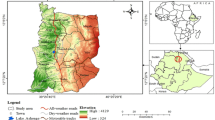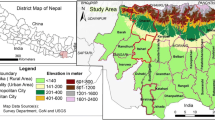Abstract
Numerous studies related to the simulation and prediction of urban growth to address land-use and land-cover (LULC) changes have been conducted in recent years, but very few have considered the impact of climate change, flooding impact, government relocation, corridor cities, and long-term rainfall variations simultaneously. To bridge the gap, this study predicts possible future LULC changes for 2030 and 2050 in Beijing (China), since Beijing is one of the fastest-growing megacities in the world. The proposed integrated modeling analysis covers four key scenarios to reflect the influences of different factors and constraints on LULC changes, in which cellular automata, Markov chain, and multi-criteria evaluation are fully coupled. While fuzzy membership function was used to address the uncertainty associated with the decision analysis, Markov chain, which is regarded as a stochastic process, was applied to predict future urban growth pathways. In addition, a statistical downscaling model driven by possible climate change scenarios was employed to address long-term rainfall variations in Beijing, China. This study differs from previous ones for Beijing in terms of not only the effects of climate change and flooding impact but also the newly-developed economic free trade zone in Xiong’an and the central government’s plan to relocate to the Tongzhou district. Findings indicate that there is no marked difference in LULC over the four key scenarios. Compared to the baseline LULC in 2010, the predicted results indicate that urban expansion is expected to increase more than 6 and 11% in 2030 and 2050, respectively.






(source: NASA 2017)







Similar content being viewed by others
References
Adamatzky AI (1994) Hierarchy of fuzzy cellular automata. Fuzzy Sets Syst 62(2):167–174
Arsanjani JJ, Helbich M, Kainz W, Boloorani AD (2013) Integration of logistic regression, Markov chain and cellular automata models to simulate urban expansion. Int J Appl Earth Obs Geoinf 21:265–275
Bagan H, Yamagata Y (2012) Landsat analysis of urban growth: how Tokyo became the world’s largest megacity during the last 40 years. Remote Sens Environ 127:210–222
Balzter H, Braun PW, Köhler W (1998) Cellular automata models for vegetation dynamics. Ecol Model 107:113–125
Batty M (2007) Cities and complexity: understanding cities with cellular automata, agent-based models, and fractals. MIT Press, Cambridge
Beijing Economic and Social Development Statistical Bulletin (2015). Beijing Bureau of Statistics. Retrieved 10 June 2017 (in Chinese)
Brocker J (1995) Chamberlinian spatial computable general equilibrium modeling: a theoretical framework. Econ Syst Res 7:137–149
Chen X, Yu SX, Zhang YP (2013) Evaluation of spatiotemporal dynamics of simulated land use/cover in China using a probabilistic cellular automata-Markov model. Pedosphere 23(2):243–255
China Knowledge (2013) Shenzhen (Guangdong) City information. Retrieved from http://www.chinaknowledge.com/CityInfo/City.aspx?Region=Coastal&City=Shenzhen
Deng Y, Srinivasan S (2016) Urban land use change and regional access: a case study in Beijing, China. Habitat Int 51:103–113
Ding WJ, Wang RQ, Wu DQ, Liu J (2013) Cellular automata model as an intuitive approach to simulate complex land-use changes: an evaluation of two multi-state land-use models in the Yellow River Delta. Stoch Env Res Risk Assess 27(4):899–907
Duan ZQ, Verburg PH, Zhang FR, Yu ZR (2004) Construction of a land-use change simulation model and its application in Haidian District, Beijing. Acta Geographica Sinica 59(6):1037–1046
Eastman J (2015) TerrSet manual. Clark Labs., Clark University, Worcester
Feng YJ, Liu Y, Batty M (2015) Modeling urban growth with GIS based cellular automata and least squres SVM rules: a case study in Qingpu-Songjiang area of Shanghai, China. Stoch Env Res Risk Assess 30(5):1387–1400
Guan Q, Wang L, Clarke KC (2005) An artificial-neural-network-based, constrained CA model for simulating urban growth. Cartogr Geogr Inf Sci 32:369–380
Gulacha MM, Mulungu DMM (2016) Generation of climate change scenarios for precipitation and temperature at local scales using SDSM in Wami-Ruvu River Basin Tanzania, physics and chemistry of the earth, Parts A/B/C, pp 1–11
Han H, Yang C, Song J (2015) Scenario simulation and the prediction of land use and land cover change in Beijing, China. Sustainability 7(4):4260–4279
He CY, Shi PJ, Chen J, Zhou YY (2001) A study on land use/cover change in Beijing area. Geogr Res 20(6):679–687
He C, Okada N, Zhang Q, Shi P, Zhang J (2006) Modeling urban expansion scenarios by coupling cellular automata model and system dynamic model in Beijing, China. Appl Geogr 26(3):323–345
He C, Okada N, Zhang Q, Shi P, Li J (2008) Modelling dynamic urban expansion processes incorporating a potential model with cellular automata. Landsc Urban Plan 86(1):79–91
Hessami M, Gachon P, Ouarda TBMJ, St-Hilaire A (2008) Automated regression-based statistical downscaling tool. Environ Model Softw 23(6):813–834
Hu Y, Zheng Y, Zheng X (2013) Simulation of land-use scenarios for Beijing using CLUE-S and Markov composite models. Chin Geogr Sci 23(1):92–100
Intergovernmental Panel on Climate Change, Working Group I (2007) Climate change 2007: The Physical Science Basis. Contribution of Working Group I to the Fourth Assessment Report of the IPCC. Cambridge University Press, Cambridge, UK
Kalnay E, Cai M (2003) Impact of urbanization and land-use change on climate. Nature 423:528–531
Lambin EF, Geist HJ, Lepers E (2003) Dynamics of land-use and land-cover change in tropical regions. Annu Rev Environ Resour 28:205–241
Li X, Yeh GO (2002) Neural-network-based cellular automata for simulating multiple land use changes using GIS. Int J Geogr Inf Sci 16(4):323–343
Li Q, Zhang C, Miao S (2005) The distribution characteristics of rainfall and the effect of land use in Beijing area. J Desert Res 25(1):60–65
Liao FHF, Wei YHD (2014) Modeling determinants of urban growth in Dongguan, China: a spatial logistic approach. Stoch Environ Resk Assess 28(4):801–816
Liu WD (2013) Thinking of economic geography. Sciences Press, Beijing, p 165
Liu JY, Kuang WH, Zhang ZX, Xu XL, Qin YW, Zhou WC, Zhang SW, Li RD, Yan CZ, Wu SX, Shi XZ, Jiang N, Yu DS, Pan XZ, Chi WF (2014) Spatiotemporal characteristics, patterns, and causes of land-usee changes in China since the late 1980s. J Geogr Sci 24(2):195–210
Long HL, Li YR, Liu YS, Woods M, Zou J (2012) Accelerated restructuring in rural China fueled by ‘increasing vs. decreasing balance’ land-use policy for dealing with hollowed villages. Land Use Policy 29(1):11–22
Miao S, Chen F, Li Q, Fan S (2011) Impacts of urban processes and urbanization on summer precipitation: a case study of heavy rainfall in Beijing on 1 August 2006. J Appl Meteorol Climatol 50(4):806–825
Mitsova D, Shuster W, Wang XH (2010) A cellular automata model of land cover change to integrate urban growth with open space conservation. Landsc Urban Plan 99(2):141–153
Muller MR, Middleton J (1994) A Markov model of land-use change dynamics in the Niagara Region, Ontario, Canada. Landsc Ecol 9:151–157
Myint SW, Wang L (2006) Multicriteria decision approach for land use land cover change using Markoc chain analysis and a cellular automata approach. Can J Remote Sens 32(6):390–404
Owen JG (2005) Estimating the cost and benefit of hosting Olympic Games: what can Beijing expect from its 2008 Games? Ind Geogr 3(1):1–18
Partridge MD, Rickman D (1998) Regional computable general equilibrium modeling: a survey and critical appraisal. Int Region Sci Rev 21:205–248
Pijanowski BC, Gage SH, Long DT, Cooper WC (2000) A land transformation model for the Saginaw Bay watershed. In: Sanderson J, Harris LD (eds) Landscape ecology: a top down approach. Lewis Publishing, Boca Raton
Shafizadeh-Moghadam H, Helbich M (2013) Spatiotemporal urbanization processes in the megacity of Mumbai, India: a Markov chains-cellular automata urban growth model. Appl Geogr 40:140–149
Shafizadeh-Moghadam H, Hagenauer J, Farajzadeh M, Helbich M (2015) Performance analysis of radial basis function networks and multi-layer perceptron networks in modeling urban change: a case study. Int J Geogr Inf Sci 29(4):606–623
Small C, Cohe JE (2004) Continental physiography, climate, and the global distribution of human, population. Curr Anthropol 45(2):269–277
Subedi P, Subedi K, Thapa B (2013) Application of a hybrid cellular automaton—Markov (CA-Markov) model in land-use change prediction: a case study of Saddle Creek Drainage Basin, Florida. Appl Ecol Environ Sci 1(6):126–132
Teutschbein C, Wetterhall F, Seibert J (2011) Evaluation of different downscaling techniques for hydrological climate-change impact studies at the catchment scale. Clim Dyn 37(9):2087–2105
Verburg PH, Soepboer W, Veldkamp A, Limpiada R, Espaldon V, Mastura SSA (2002) Modeling the spatial dynamics of regional land use: the CLUE-S model. Environ Manag 30(3):391–405
White R, Engelen G (1993) Cellular automata and fractal urban form: a cellular modelling approach to the evolution of urban land-use patterns. Environ Plan A 25:1175–1199
Wilby RL, Dawson CW, Barrow EM (2002) SDSM—a decision support tool for the assessment of regional climate change impacts. Environ Model Softw 17(2):145–157
World Bank (2015) World Bank national accounts data and OECD National Accounts data files. Retrieved from http://data.worldbank.org/indicator/NY.GDP.MKTP.KD.ZG?locations=CN
World Population Review (2016) Shenzhen Population. Retrieved from http://worldpopulationreview.com/world-cities/shenzhen-population/
Wu F (1998) SimLand: a prototype to simulate land conversion through the integrated GIS and CA with AHP-derived transition rules. Int J Geogr Inf Sci 12(1):63–82
Wu Q, Li HQ, Wang RS, Paulussen J, He Y, Wang M, Wang BH, Wang Z (2006) Monitoring and predicting land use change in Beijing using remote sensing and GIS. Landsc Urban Plan 78(4):322–333
Wu DQ, Liu J, Wang SJ, Wang RQ (2010) Simulating urban expansion by coupling a stochastic cellular automata model and socioeconomic indicators. Stoch Env Res Risk Assess 24(2):235–245
Zhang CL, Chen F, Miao SG, Li QC, Xia XA, Xuan CY (2009) Impacts of urban expansion and future green planting on summer precipitation in the Beijing metropolitan area. J Geophys Res 114:D02116
Zhou Y, Zhang F, Du ZH, Ye XY, Liu RY (2017) Integrating cellular automata with the deep belief network for simulating urban growth. Sustainability 9(10):1786
Acknowledgements
This research is supported by the Global Innovation Initiative (British Council Gll206) and funded by the British Council and the Department for Business, Innovation and Skills. The authors are grateful for the help from Dr. Kaixu Bai in collecting the land use maps.
Author information
Authors and Affiliations
Corresponding author
Rights and permissions
About this article
Cite this article
Lu, Q., Chang, NB. & Joyce, J. Predicting long-term urban growth in Beijing (China) with new factors and constraints of environmental change under integrated stochastic and fuzzy uncertainties. Stoch Environ Res Risk Assess 32, 2025–2044 (2018). https://doi.org/10.1007/s00477-017-1493-x
Published:
Issue Date:
DOI: https://doi.org/10.1007/s00477-017-1493-x




